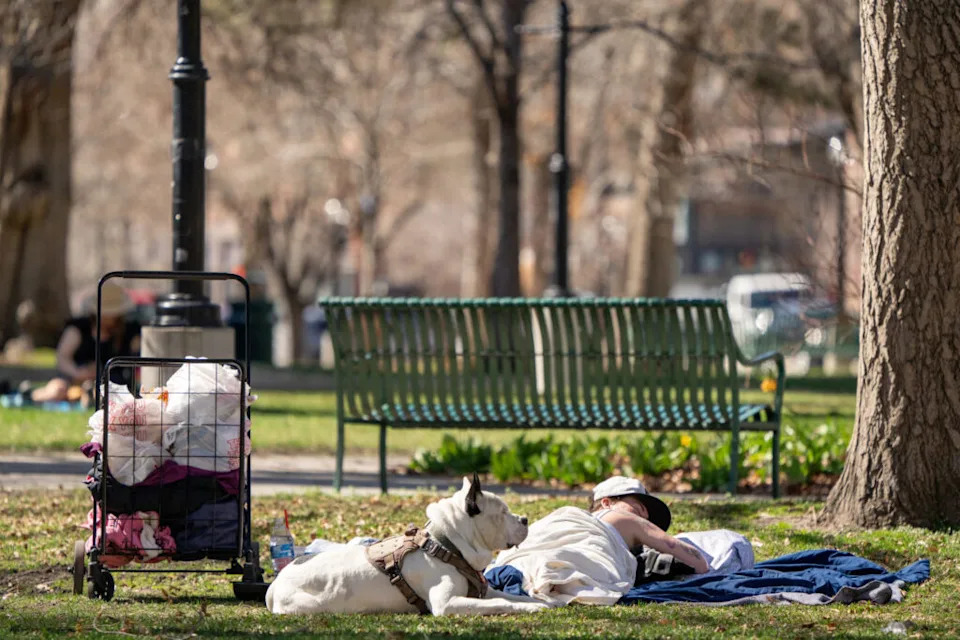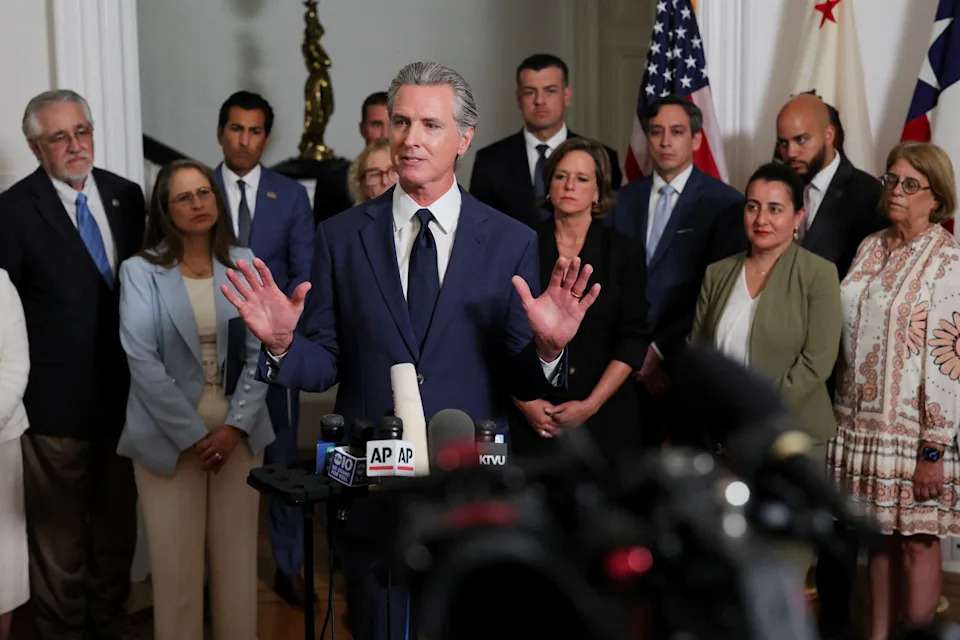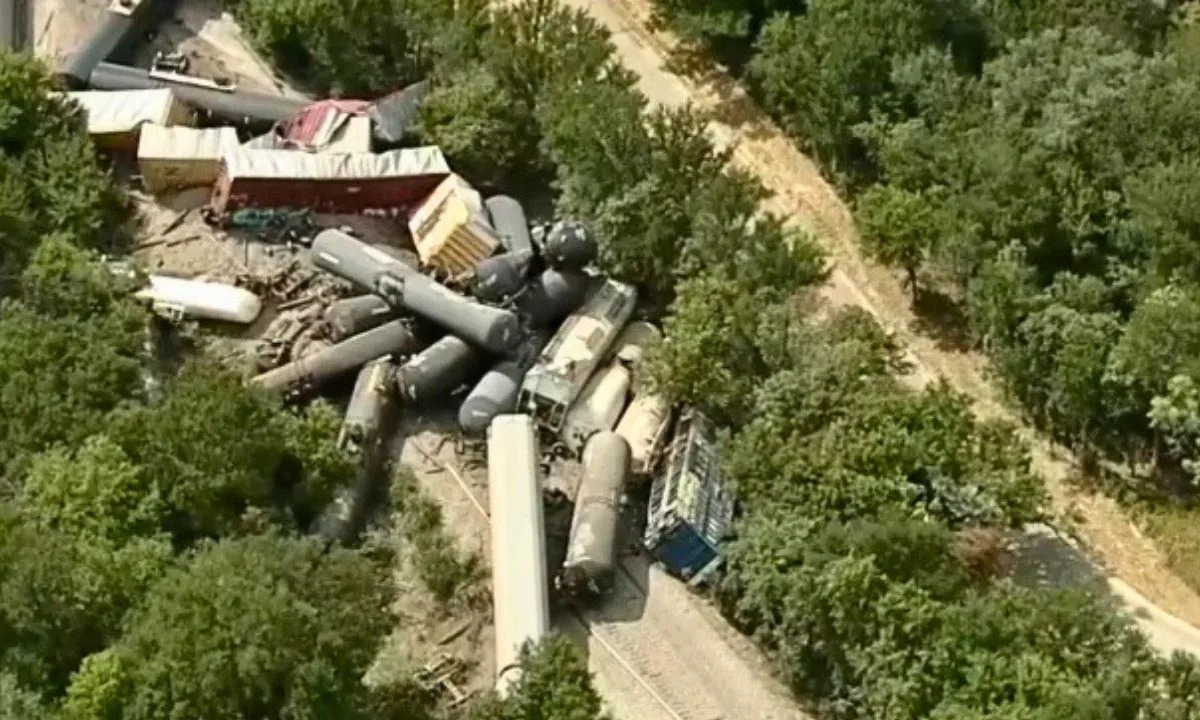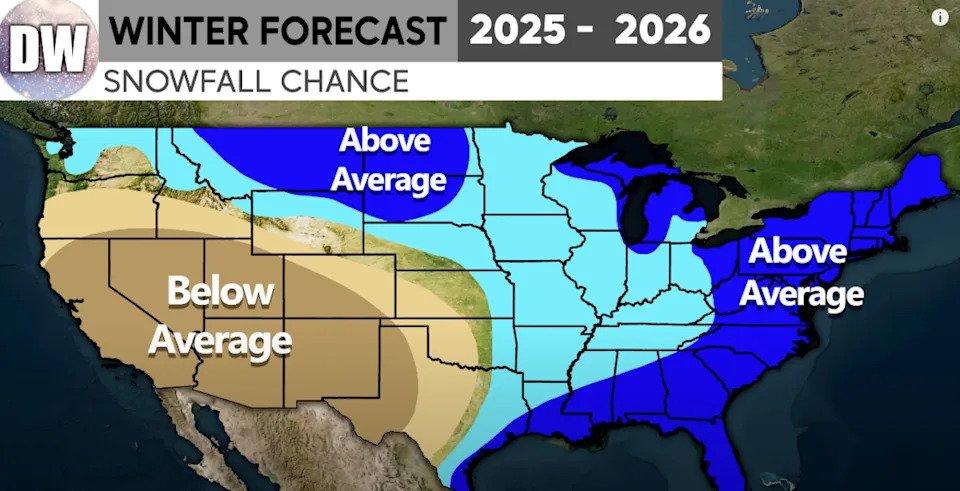
People congregate around the Geraldine E. King Women’s Center in Salt Lake City on Wednesday, March 26, 2025. (Photo by Spenser Heaps for Utah News Dispatch)
Though Utah’s rate of homelessness remains below the national average, a new report shows the state’s homeless population is continuing to rise — and the start of 2025 marked a significant uptick.
“It’s a big jump,” Wayne Niederhauser, Utah Gov. Spencer Cox’s state homeless coordinator, told Utah News Dispatch ahead of the report’s release Wednesday. “We haven’t seen that kind of jump for years.”
The annual 2025 Point-in-Time Count — which is a national tally of sheltered and unsheltered people on a single night in January — showed 4,584 Utahns were experiencing homelessness in January 2025, up by 715 people from last year, an 18% increase.
Utah’s homelessness rate is now 13 per 10,000 people, up from 11 per 10,000. But even though Utah is one of the fastest-growing states in the nation and has faced skyrocketing housing prices over the past five years, its rate of homelessness is still well below the 2024 national rate, which was 23 per 10,000.
Though Niederhauser said it’s concerning to see an 18% jump, he said there is a “silver lining.”
“The silver lining is that 95% of those extra individuals were in shelter and not unsheltered,” he said.
In the past several years, Niederhauser said Utah has typically seen only a 4% or 5% rate increase, but about 80% of those people were unsheltered. This year, he said, “the good part about that data point is that most of those individuals were sheltered.”
Of the 715 additional people experiencing homelessness during the 2025 Point-in-Time Count, 677 (95%) were sheltered and 38 (5%) were unsheltered, which the Utah Office of Homeless Services described in the report’s key findings as a “dramatic shift” from 2024, when that year’s count rose by 131 people, but only 23 (18%) were sheltered while 108 (82%) were unsheltered.
“This year’s dramatic increase in sheltered individuals compared to unsheltered is largely attributed to the expansion of winter shelter capacity, which allowed more individuals experiencing homelessness to access shelter,” the report says.
This year’s Point-in-Time Count took place during Code Blue temperatures, which prompted expansion of shelter capacity. Volunteers also questioned whether increased anti-camping enforcement, along with the frigid temperatures, could have factored into seeing fewer people on the streets.
The report also includes several other notable findings, including:
Rising child homelessness: The number of Utah children experiencing homelessness increased from 589 to 662, a 22% increase. Children now make up 14% of Utah’s total Point-in-Time Count, which is still below 2024 national data, when children accounted for 19% of people experiencing homelessness across the U.S.
More unhoused seniors: The number of Utahns over the age of 64 experiencing homelessness rose from 251 to 356, an increase of 42%. The increase, state officials wrote, “may reflect broader demographic shifts,” with Utah’s population of those 65 and older growing by nearly 58% from 2013 to 2023 and expected to double by 2060, according to the Kem C. Gardner Policy Institute. But at the same time, “more seniors are being priced out of housing, often living on fixed incomes that can’t keep pace with rising rents and property costs,” state officials wrote.
Veterans experiencing homelessness: The number of veterans experiencing homelessness grew by 36%, rising from 121 to 165. “While this represents a notable year-over-year increase, the 2025 total remains within the historical range, falling between the 2023 count of 181 and the 2022 count of 155.
A rise in first-time homelessness: Factoring in not just people tallied during the Point-in-Time Count, but also those who accessed homeless services according to the state’s database, a total of 10,261 people in Utah experienced homelessness in 2024 for the first time, an increase of 5% from 2023. The state’s homelessness data dashboard shows 5,122 people were categorized as “previously homeless,” only a slight uptick from 4,942 people in 2023. In total, the state’s database reported 15,383 people accessing services in 2024 statewide.
To Niederhauser, the report shows even though Utah homelessness is rising — following a national trend of Americans faced with higher housing costs, inflation, and wages that aren’t keeping pace with cost of living — the state’s homeless system is providing options that those additional people are using rather than living on the streets.
“There’s an increase in homelessness, but we’re addressing it in an effective way,” he said.
In the report’s executive summary, Niederhauser highlighted a list of investments the 2025 Utah Legislature made to improve Utah’s homeless system, including:
$3.9 million in ongoing funding to launch and operate a second family shelter in the Salt Lake Valley. Renovated from a Motel 6, the Family Interim Non-Congregate Housing Facility, or FINCH for short, opened in April.
$5.5 million in one-time funding was allocated for the 2026 fiscal year to expand emergency shelter operations during cold weather. In the 2025 fiscal year, investment in winter response supported 901 additional winter shelter beds, including 256 Code Blue beds and 3,370 emergency shelter nights provided in a hotel setting.
$16.7 million in ongoing, annually adjusted funding was distributed to cities hosting homeless shelters to help mitigate their impacts.
What’s working and where are more resources needed?
The report showed some progress toward the state homeless system’s goals of making homelessness “rare, brief and nonrecurring,” but also areas where the system is falling short.
For example, state data showed a slight decrease in the number of days people are staying in emergency shelters. In 2024, 75% of emergency shelter stays were 90 days or less, down from 80% in 2023 and below previous years.
“While this trend indicates people are experiencing homelessness for longer periods of time, most only need short-term shelter support before restabilizing,” the report stays.
SUBSCRIBE: GET THE MORNING HEADLINES DELIVERED TO YOUR INBOX
However, the average length of stay in emergency shelter increased by 10 days (17%) compared to 2023, “highlighting the growing difficulty individuals face in securing stable housing,” the report says. “This trend underscores the urgent need for faster housing placements and a broader range of exit options from shelter.”
The number of Utahns experiencing chronic homelessness also remains an issue. According to the 2025 Point-in-Time Count, 1,233 were experiencing chronic homelessness — a 36% rise from 906 in 2024. But that group represented 27% of the total Point-in-Time Count, similar to 28% in 2023.
“This highlights the continued need for supportive services for individuals with disabilities and long histories of homelessness, while also confirming that chronic homelessness remains a minority of the overall homeless population in Utah,” the report says.
The report also showed, however, that supportive housing has continued to be a “key driver of long-term stability” for people exiting homelessness. For example, state data shows:
93% of people in permanent supportive housing “either retained their housing or moved on to other permanent options.” 2024 marked the “fourth consecutive year this success rate has held steady.”
In 2024, the percentage of people returning to homelessness within two years of exiting to permanent supportive housing declined slightly from 25% to 24%.
“These outcomes underscore the effectiveness of permanent supportive housing with wrap-around services in keeping Utah’s most vulnerable residents stably housed,” the report said.
In recent years, while lawmakers have put more money toward homeless services than they have in the past, there are still plenty of requests for more money that have gone unfunded. In 2025, lawmakers approved some but not all of the funding requests Niederhauser and his office asked for, leaving funding gaps that local officials have had to find ways to fill.

As his office prepares for another budget proposal, Niederhauser said his message to lawmakers for the upcoming 2026 general session in January is to acknowledge Utah’s homeless population is increasing. He also noted that the data shows the length of time people are staying in shelters has increased, indicating there’s a “gap” that needs to be filled when it comes to providing options for people to cycle out of emergency shelters.
“That’s the service that we really need to focus on,” he said, including additional beds at the Utah State Hospital or expanding capacity in other areas of the state’s mental health system, as well as increasing capacity for supportive housing.
“That is a good message for all of us, and it’s a good takeaway for the Legislature — for us to really focus on that big gap that we have for some of those services,” Niederhauser said. “If those are available, then the nights (people) spend in shelter goes down.”
For the first time, Utah’s Point-in-Time Count this year also included survey questions asking unsheltered people what type of shelter they would use if available. Its findings said:
610 preferred private rooms
568 preferred “bring-your-own setups (cars, tents, RVs) with shared facilities”
511 said they would use small units with shared bathrooms
356 were open to congregate shelters
236 said none of the above.
Niederhauser said that survey “confirms” what state and local leaders have been hearing for a long time – that providing a range of options for people will help keep more people off of the streets. He pointed to the 50-bed “microshelter” community that opened last fall as a model that’s been a success, with plans to add another 54 units in coming months.
“That kind of model we’re very bullish on because the outcomes have been excellent,” Niederhauser said.
He also said those survey questions are expected to inform the design of a planned 1,200- to 1,600-bed homeless campus, which is expected to offer both congregate and non-congregate shelter options.
Efforts to site 1,200- to 1,600-bed homeless campus still underway
Lawmakers also passed legislation to allow the state to use eminent domain powers to “accelerate site acquisition” for a planned “transformative homeless services campus, with statutory authority limited to a defined area in Salt Lake City, northeast of the airport,” the report’s executive summary said.
Niederhauser and other state officials have been working for months to site that homeless campus (expected to include 1,200 to 1,600 beds), but they have not yet announced what properties they’ve been eying. Last fall, the Utah Homeless Services Board set a deadline of Oct. 1, 2025 for the campus to be built, but Niederhauser said the siting process has been taking longer than expected.
“Our timeline is ASAP,” Niederhauser said when asked about a new timeline for selecting the property for the homeless campus. “We know this is needed. We are looking at several properties, all of which have some difficult situations to overcome, like wetlands. I’ll highlight wetlands, because wetlands isn’t something I can solve in two weeks, three months, or even six months because the Army Corps of Engineers has to be involved in that, and there’s a process you have to go through.”
Depending on the outcomes of those evaluations, Niederhauser said that will determine whether state officials move forward with eminent domain powers to site the campus. He said a new timeline is not yet clear, but “we’re not sitting on this.”
“We are working hard,” he said, adding that it’s been challenging to find a property along the Wasatch Front, which has limited property available that hasn’t already been developed. “Unfortunately, you know, the need is huge. We appreciate the acute need, the serious need of this. So we’re not letting grass grow under our feet. We’re working hard to find a pathway.”








Comments